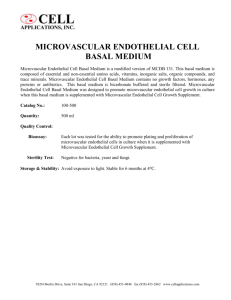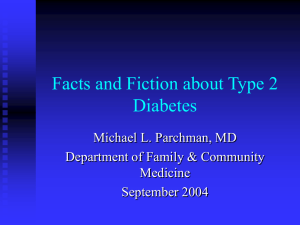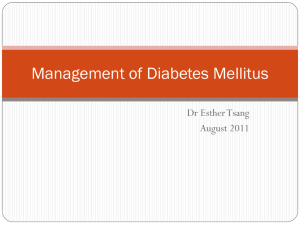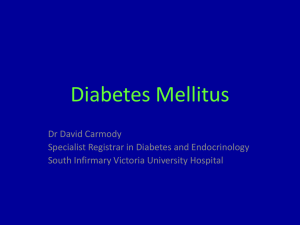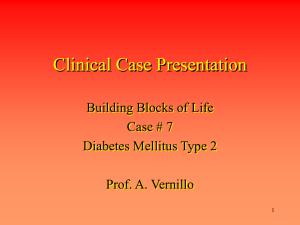COMPLICATIONS OF DIABETES MELLITUS
advertisement
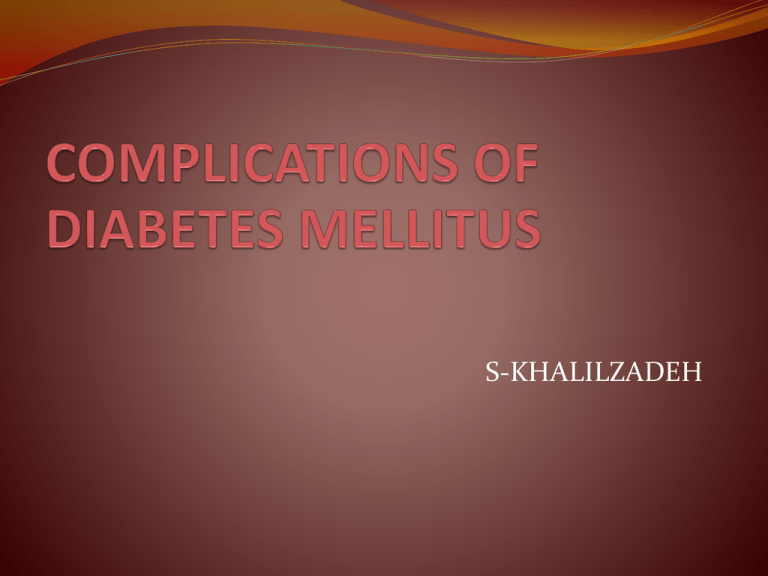
S-KHALILZADEH BIOCHEMISTRY AND MOLECULAR CELL BIOLOGY All forms of diabetes, both inherited and acquired, are characterized by hyperglycemia, a relative or absolute lack of insulin, and the development of diabetesspecific microvascular pathology in the retina, renal glomerulus, and peripheral nerve Diabetes is also associated with accelerated atherosclerotic macrovascular disease affecting arteries that supply the heart, brain, and lower extremities. Pathologically, this condition resembles macrovascular disease in nondiabetic patients, but it is more extensive and progresses more rapidly. As a consequence of its microvascular pathology, diabetes mellitus is now the leading cause of new blindness in people 20 to 74 years of age and the leading cause of end-stage renal disease (ESRD). More than 60% of diabetic patients are affected by neuropathy, which includes distal symmetrical polyneuropathy (DSPN), mononeuropathies, and a variety of autonomic neuropathies causing erectile dysfunction, urinary incontinence, gastroparesis, and nocturnal diarrhea. Accelerated lower extremity arterial disease in conjunction with neuropathy makes diabetes mellitus account for 50% of all nontrauma amputations in the United States. The risk of cardiovascular complications is increased by twofold to sixfold in subjects with diabetes. Overall, life expectancy is about 7 to 10 years shorter than for people without diabetes mellitus because of increased mortality from diabetic complications Large prospective clinical studies show a strong relationship between glycemia and diabetic microvascular complications in both type 1 diabetes mellitus (T1DM) and type 2 diabetes (T2DM). There is a continuous, though not linear, relationship between level of glycemia and the risk of development and progression of these complications .Hyperglycemia and the consequences of insulin resistance both appear to play important roles in the pathogenesis of macrovascular complications Shared Pathophysiologic Features of Microvascular Complications In the retina, glomerulus, and vasa nervorum, diabetes-specific microvascular disease is characterized by similar pathophysiologic features. Requirement for Intracellular Hyperglycemia 2. Abnormal Endothelial Cell Function 3. Increased Vessel Wall Protein Accumulation 4. Microvascular Cell Loss and Vessel Occlusion 1. Requirement for Intracellular Hyperglycemia Clinical and animal model data indicate that chronic hyperglycemia is the central initiating factor for all types of diabetic microvascular disease. Duration and magnitude of hyperglycemia are both strongly correlated with the extent and rate of progression of diabetic microvascular disease In the Diabetes Control and Complications Trial (DCCT), for example, T1DM patients whose intensive insulin therapy resulted in hemoglobin A1c (Hb A1c) levels 2% lower than those receiving conventional insulin therapy had a 76% lower incidence of retinopathy, a 54% lower incidence of nephropathy, and a 60% reduction in neuropathy Although all diabetic cells are exposed to elevated levels of plasma glucose, hyperglycemic damage is limited to those cell types (e.g., endothelial cells) that develop intracellular hyperglycemia Abnormal Endothelial Cell Function Early in the course of diabetes mellitus, before structural changes are evident, hyperglycemia causes abnormalities in blood flow and vascular permeability in the retina, glomerulus, and peripheral nerve vasa nervorum Early in the course of diabetes, increased permeability is reversible; as time progresses, however, it becomes irreversible. Increased Vessel Wall Protein Accumulation The common pathophysiologic feature of diabetic microvascular disease is progressive narrowing and eventual occlusion of vascular lumina, which results in inadequate perfusion and function of the affected tissues. Early hyperglycemia-induced microvascular hypertension and increased vascular permeability contribute to irreversible microvessel occlusion by three processes. CONTINUE The first process is an abnormal leakage of periodic acid– Schiff (PAS)-positive, carbohydrate-containing plasma proteins, which are deposited in the capillary wall and can stimulate perivascular cells such as pericytes and mesangial cells to elaborate growth factors and extracellular matrix The second is extravasation of growth factors, such as transforming growth factor β1 (TGF-β1), which directly stimulates overproduction of extracellular matrix components[15] and can induce apoptosis in certain complication-relevant cell types. The third is hypertension-induced stimulation of pathologic gene expression by endothelial cells and supporting cells, which include GLUT1 glucose transporters, growth factors, growth factor receptors, extracellular matrix components, and adhesion molecules that can activate circulating leukocytes Microvascular Cell Loss and Vessel Occlusion The progressive narrowing and occlusion of diabetic microvascular lumina are also accompanied by microvascular cell loss In the retina, diabetes mellitus induces programmed cell death of Müller cells and ganglion cells,[19] pericytes, and endothelial cells.[20] In the glomerulus, declining renal function is associated with widespread capillary occlusion and podocyte loss, but the mechanisms underlying glomerular cell loss are not yet known. In the vasa nervorum, endothelial cell and pericyte degeneration occur,[21] and these microvascular changes appear to precede the development of diabetic peripheral neuropathy.[ Development of Microvascular Complications during Posthyperglycemic Euglycemia Another common feature of diabetic microvascular disease has been termed hyperglycemic memory, or the persistence or progression of hyperglycemia-induced microvascular alterations during subsequent periods of normal glucose homeostasis In contrast, lower levels of hyperglycemia made patients more resistant to damage from subsequent higher levels. Genetic Determinants of Susceptibility to Microvascular Complications Clinicians have long observed that different patients with similar duration and degree of hyperglycemia differ markedly in their susceptibility to microvascular complications Pathophysiologic Features of Macrovascular Complications Unlike microvascular disease, which occurs only in patients with diabetes mellitus, macrovascular disease resembles that in subjects without diabetes However, subjects with diabetes have more rapidly progressive and extensive cardiovascular disease (CVD), with a greater incidence of multivessel disease and a greater number of diseased vessel segments than nondiabetic persons The importance of hyperglycemia in the pathogenesis of diabetic macrovascular disease is suggested by the observation that glycohemoglobin A1 is an independent risk factor for CVD Insulin resistance occurs in the majority of patients with T2DM and in two thirds of subjects with impaired glucose tolerance.Both these groups have a significantly higher risk of developing CVD Insulin resistance is commonly associated with a proatherogenic dyslipidemia Insulin resistance is associated with a characteristic lipoprotein profile that includes a high very-lowdensity lipoprotein (VLDL), a low high-density lipoprotein (HDL), and small, dense LDL. Mechanisms of Hyperglycemia-Induced Damage Mitochondrial superoxide overproduction Increased Polyol Pathway Flux → Increased Intracellular Advanced Glycation EndProduct Formation Activation of Protein Kinase C Increased Hexosamine Pathway Flux Potential pathways leading to the formation of advanced glycation end product (AGE) from intracellular dicarbonyl precursors. Potential mechanisms by which intracellular production of advanced glycation end-product (AGE) precursors damages vascular cells. hyperglycemia-induced protein kinase C (PKC) activation Hyperglycemia increases diacylglycerol (DAG) content, which activates PKC, primarily the β and δ isoforms. Activated PKC has a number of pathogenic consequences. The hexosamine pathway The glycolytic intermediate fructose-6-phosphate (Fruc-6-P) is converted to glucosamine-6phosphate (Glc-6-P) by the enzyme glutamine:fructose 6phosphate amidotransferase (GFAT). Increased donation of NAcetylglucosamine moieties to serine and threonine residues of transcription factors such as Sp1 increases production of such complication-promoting factors as PAI-1 and TGF-β1 .

